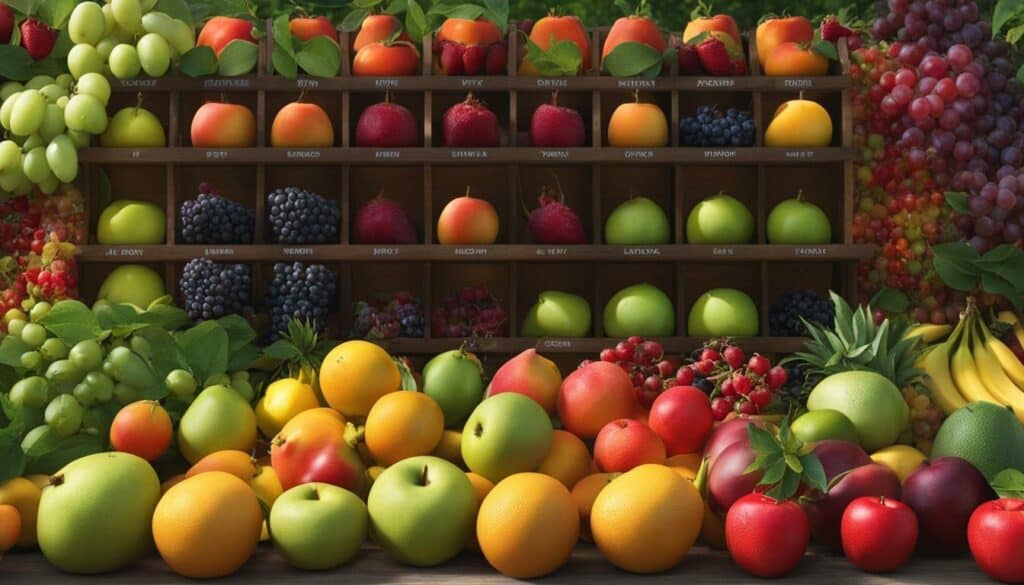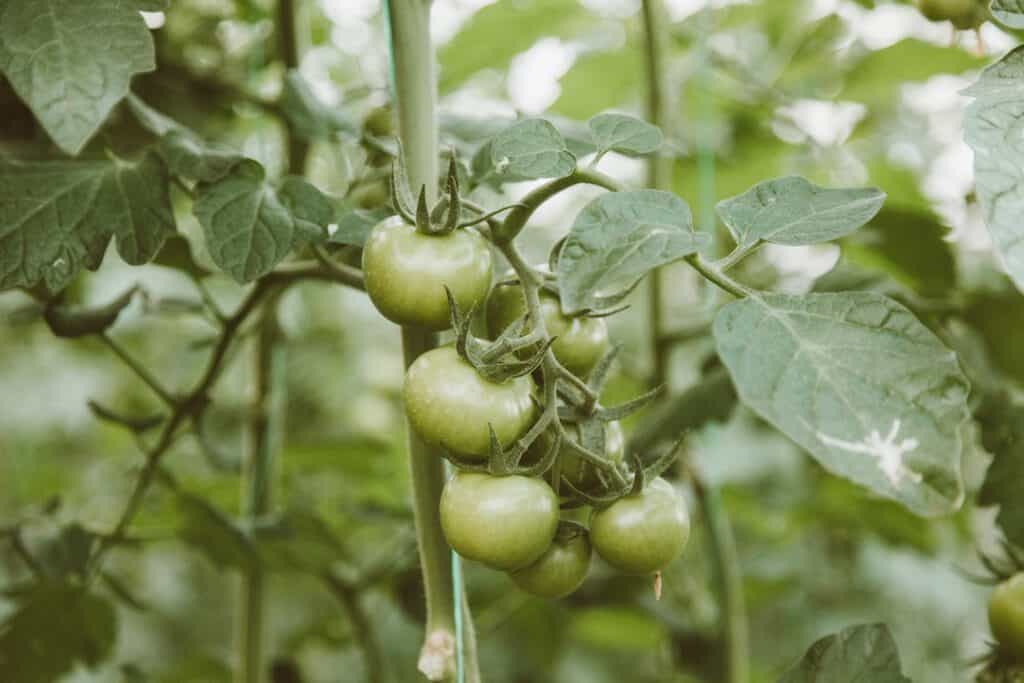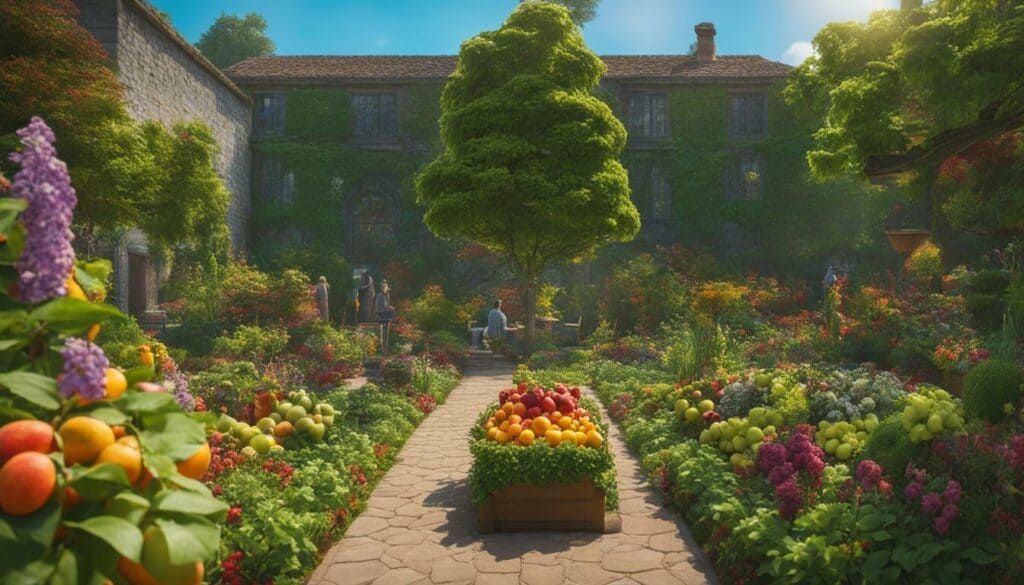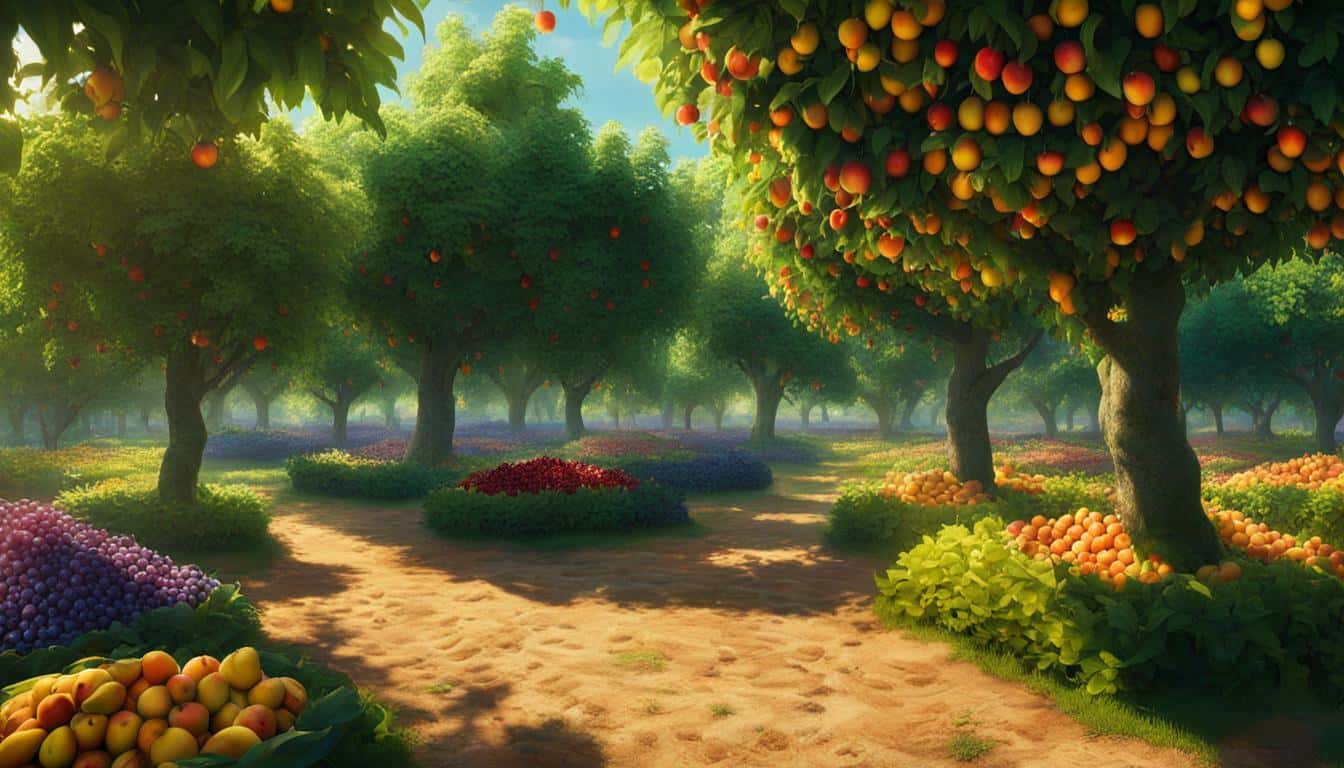Welcome to the ultimate guide on fruit gardens for beginners. Whether you have a green thumb or are completely new to gardening, this comprehensive guide will help you get started on growing your own delicious fruits right in your backyard. With step-by-step instructions and helpful tips, you’ll learn everything you need to know to create a thriving fruit garden that will provide you with fresh and tasty produce for years to come.
Key Takeaways:
- Starting a fruit garden can be a rewarding and enjoyable experience for beginners.
- By selecting the right fruit varieties for your climate and space, you can increase your chances of success.
- Having the essential tools and following proper planting and caring techniques will help your fruit trees thrive.
- Easy-to-grow fruit plants are a great option for beginners who want low-maintenance options.
- Using tips and tricks for successful fruit gardening will help you overcome common challenges.
- Designing and planning your fruit garden will optimize space and create an aesthetically pleasing layout.
- Understanding and addressing common challenges such as pests and diseases will contribute to a successful fruit garden.
- By following this ultimate guide, you’ll be well-equipped to start your own fruit garden and enjoy the benefits of homegrown fruit.
Why Start a Fruit Garden?
There are countless reasons why starting a fruit garden is a fantastic endeavor, especially for beginners. Not only do fruit gardens offer a sense of satisfaction and joy, but they also provide an abundant supply of fresh, healthy fruits right at your fingertips.
Growing your own fruit allows you to have control over the quality and taste of the produce. You can choose to grow organic fruit, free from pesticides and chemicals, ensuring that you and your family are consuming the healthiest options. Plus, there’s nothing quite like the satisfaction of picking a ripe, juicy fruit from your own garden and enjoying it at its peak flavor.
Starting a fruit garden is also a great way to connect with nature and get outdoors. Gardening has numerous mental and physical health benefits, including stress reduction, increased physical activity, and improved mood. Tending to your fruit plants and watching them grow can be a therapeutic and rewarding experience.
Another advantage of fruit gardening is the cost savings. Buying fresh fruit from the store can be expensive, especially if you prefer organic options. By growing your own, you can save money in the long run and create a sustainable source of delicious fruits.
Furthermore, fruit gardening offers a wide variety of options to suit your taste and preferences. You can choose from a wide range of fruit varieties, including apples, berries, citrus fruits, peaches, and more. This allows you to tailor your garden to your favorite fruits, ensuring that you always have a bountiful supply of your preferred flavors.
Whether you have a large backyard or a small balcony, fruit gardening is accessible to everyone. Even if you don’t have a lot of space, you can grow fruit plants in containers or utilize vertical gardening techniques such as espaliers and cordons. This makes fruit gardening a beginner-friendly activity that can be enjoyed by anyone with a passion for growing their own food.
In conclusion, starting a fruit garden is a wonderful choice for beginners. It offers an array of benefits, including fresh and healthy produce, a connection with nature, cost savings, and the ability to personalize your garden to your preferences. So why not embark on this exciting journey and experience the joys of fruit gardening for yourself?

Sources:
- https://example.com/fruit-gardening-for-beginners
- https://example.com/beginners-guide-to-fruit-gardening
- https://example.com/why-start-a-fruit-garden
Selecting the Right Fruit Varieties for Beginners
When it comes to choosing fruit varieties for your beginner’s garden, it’s important to consider factors such as your climate, available space, and personal taste preferences. Selecting the right fruit varieties will set you up for success and ensure a bountiful harvest. Here are some tips to help you make the best choices:
- Consider your climate: Different fruits thrive in different climates, so it’s important to choose varieties that are well-suited to your specific region. Research the hardiness zones and temperature requirements for different fruit trees and plants to ensure they can withstand the conditions in your area.
- Assess your available space: Take into account the size and layout of your garden or growing area. Some fruit trees, like standard apple or pear trees, can grow quite large and may not be suitable for small spaces. Consider dwarf or semi-dwarf varieties if you have limited space. For those with even less space, container gardening or trained fruit trees like cordons or espaliers can be great options.
- Think about personal preferences: What fruits do you and your family enjoy eating the most? Focus on growing varieties that you will truly appreciate and savor. Whether it’s juicy strawberries, tangy blueberries, or crisp apples, growing fruits that you love will make the gardening experience even more rewarding.
Remember that each fruit variety has its own specific requirements for soil, sunlight, and care. Be sure to research and familiarize yourself with the needs of the specific fruits you choose to grow. It’s also a good idea to consult with local gardening experts or nurseries to get advice on the best fruit varieties for your beginner’s garden.

Choosing the right fruit varieties for your garden is like creating a personal fruit menu. Consider your climate, available space, and personal taste preferences to ensure a successful and delicious harvest.
Here are some popular fruit varieties that are known to be beginner-friendly and easy to grow:
| Fruit | Description |
|---|---|
| Strawberries | A versatile fruit that can be grown in containers or in the ground. They have a sweet and tangy flavor and are great for snacking, baking, and preserving. |
| Blueberries | These small, antioxidant-rich berries are packed with flavor and are perfect for adding to smoothies, baking, or enjoying fresh. They thrive in acidic soil and require regular watering. |
| Apples | With so many apple varieties to choose from, you can find one that suits your taste preferences. Consider dwarf or semi-dwarf apple trees for smaller spaces. Apples are great for eating fresh, baking, and making cider. |
| Raspberries | These sweet and tart berries are a popular choice for beginners. They can be grown as bushes or trained on a trellis. Raspberries are delicious eaten fresh or used in jams, jellies, and desserts. |
| Peaches | Known for their juicy and aromatic flesh, peaches are a delightful addition to any fruit garden. Choose a variety that is suited to your climate and provide them with plenty of sunlight and well-drained soil. |
Additional Tips:
- Consider planting a mix of fruit varieties to ensure a continuous harvest throughout the season.
- Research and follow proper planting and care guidelines for each fruit variety to maximize their growth and productivity.
- Take note of any pest or disease resistance traits when selecting fruit varieties to minimize the need for chemical treatments.
By selecting the right fruit varieties for your beginner’s garden, you’ll set yourself up for a successful and rewarding fruit-growing experience. Remember to have fun, be patient, and enjoy the journey as you watch your fruit garden flourish!
Essential Tools for a Beginner’s Fruit Garden
To set yourself up for success in your fruit gardening journey, it’s essential to have the right tools at your disposal. Here are some must-have tools for a beginner’s fruit garden:
Gardening Gloves

Gardening gloves are a crucial tool for protecting your hands from thorns, prickly plants, and dirt. Look for gloves that fit well and provide good grip to help you handle plants and tools with ease.
Pruning Shears
Pruning shears, also known as secateurs, are needed for trimming and shaping your fruit trees and plants. Choose a pair with a sharp blade and comfortable grip to make clean cuts and promote healthy growth.
Trowel
A trowel is a small handheld tool that is perfect for digging small holes and transplanting seedlings. Look for one with a sturdy handle and a sharp, pointed blade for easier soil work.
Hand Pruners
Hand pruners are useful for cutting smaller branches and stems. Opt for a pruner that is easy to handle and has a cutting mechanism that suits your strength and hand size.
Garden Fork
A garden fork is helpful for loosening compacted soil and removing weeds. Look for a sturdy fork with sharp tines for easier digging and lifting.
Wheelbarrow
A wheelbarrow is invaluable for transporting heavy loads of soil, compost, and plants around your garden. Choose one with a sturdy frame and good balance for easy maneuverability.
Watering Can or Hose
A watering can or hose is essential for watering your fruit plants. Choose a watering can with a fine rose attachment or a hose with a gentle spray nozzle for efficient watering.
Pruning Saw
A pruning saw is necessary for cutting larger branches or removing damaged wood from your fruit trees. Look for a saw with a sharp, durable blade and a comfortable handle for precise pruning.
Measuring Tape
A measuring tape is crucial for ensuring proper spacing between plants and for planning the layout of your fruit garden. Having accurate measurements will help you optimize the use of your garden space.
Garden Rake
A garden rake is essential for leveling soil, removing debris, and creating smooth seedbeds. Choose a rake with sturdy teeth and a comfortable handle for easy and efficient raking.
With these essential tools, you’ll be well-equipped to start your fruit gardening journey with confidence. Remember to invest in quality tools that will last and take proper care of them to ensure their longevity. Happy gardening!
Planting and Caring for Fruit Trees for Beginners
Planting and caring for fruit trees may seem intimidating for beginners, but with the right guidance, it can be a straightforward and rewarding process. Here is a step-by-step guide to help you get started on the right foot.
- Choose the right tree: Select fruit tree varieties that are suitable for your climate and space availability. Consider factors such as chill hours, pollination requirements, and disease resistance. Research which varieties are known to thrive in your area.
- Prepare the soil: Ensure that your soil is well-drained and rich in organic matter. Remove any weeds or grass from the planting area. Dig a hole that is wide and deep enough to accommodate the tree’s roots.
- Plant the tree: Place the tree in the hole, making sure that the graft union (the swollen area where the tree was grafted onto the rootstock) is above the soil line. Backfill the hole with soil, gently tamping it down to eliminate air pockets.
- Water thoroughly: After planting, water the tree deeply to settle the soil and provide moisture for the roots. Water regularly, especially during dry periods, but avoid overwatering, as this can lead to root rot.
- Apply mulch: Spread a layer of organic mulch, such as wood chips or compost, around the base of the tree. This will help conserve moisture, suppress weeds, and improve the soil over time.
- Prune for structure: Pruning helps shape the tree and promotes healthy growth. Remove any damaged or crossing branches, and maintain an open center to allow sunlight to reach all parts of the tree.
- Fertilize as needed: Fruit trees benefit from regular fertilization to maintain their health and productivity. Use a balanced fertilizer formulated for fruit trees and follow the package instructions for application rates.
- Monitor for pests and diseases: Keep a close eye on your fruit tree for any signs of pests or diseases. Early detection and proper treatment can help prevent major damage. Consult a local gardening expert or extension service for advice on pest and disease management.
- Harvest at the right time: Different fruit varieties have different ripening times. Learn when to harvest your fruits by observing their color, texture, and taste. Use a gentle hand when picking to avoid damaging the fruit or tree.
Following these steps will help you establish and care for your fruit trees with confidence. Remember to be patient, as it may take a few years for your trees to reach full production. With proper care and attention, you’ll soon enjoy the delicious fruits of your labor!

“Following these steps will help you establish and care for your fruit trees with confidence. Remember to be patient, as it may take a few years for your trees to reach full production. With proper care and attention, you’ll soon enjoy the delicious fruits of your labor!”
Common Mistakes to Avoid
- Planting too deep: Make sure the graft union is above the soil line to prevent rootstock suckers from growing.
- Overwatering: Water deeply but avoid excessive watering that can lead to root rot.
- Neglecting pruning: Prune regularly to maintain the tree’s shape and promote healthy growth.
- Skipping fertilization: Regular fertilization is essential for the tree’s health and productivity.
- Ignoring pests and diseases: Stay vigilant and address any pest or disease issues promptly.
By avoiding these common mistakes, you’ll give your fruit trees the best chance to thrive and produce bountiful harvests for years to come.
If you’re a beginner looking for fruit plants that are low maintenance and highly rewarding, look no further. Here are some easy-to-grow fruit plants that will thrive in your garden:
Blueberries: Blueberries are a popular choice for beginner fruit gardeners. They are relatively low maintenance and can be grown in containers or in the ground. Blueberries require acidic soil, so make sure to amend your soil accordingly. They are also known for their health benefits, as they are packed with antioxidants.
Strawberries: Strawberries are another easy-to-grow fruit plant that is perfect for beginners. They can be grown in containers, raised beds, or in the ground. Strawberries prefer well-drained soil and ample sunlight. They produce sweet and juicy berries that are perfect for snacking or using in desserts.
Raspberries: Raspberries are a delicious addition to any fruit garden. They can be grown as erect varieties or as trailing varieties that require support. Raspberries prefer well-drained soil and full sunlight. They produce abundant crops of sweet and tangy berries that are perfect for eating fresh or using in jams and jellies.
| Fruit Plant | Growing Conditions | Harvest Time |
|---|---|---|
| Blueberries | Acidic soil, full sunlight | Mid-summer to early fall |
| Strawberries | Well-drained soil, full sunlight | Spring to early summer |
| Raspberries | Well-drained soil, full sunlight | Summer to early fall |
“Growing your own fruit and vegetables is a fun and rewarding way to use your garden.” – Gardening Expert
Tips for Growing Easy-to-Grow Fruit Plants:
- Choose varieties that are suited to your climate and growing conditions.
- Provide adequate sunlight, water, and nutrients for optimal growth.
- Protect your fruit plants from pests and diseases by implementing proper pest control measures.
- Prune your fruit plants regularly to promote healthy growth and improve fruit production.
- Harvest your fruits at the peak of ripeness for the best flavor and quality.
By following these tips and selecting easy-to-grow fruit plants, you can enjoy a bountiful harvest right in your own backyard. So why wait? Start your fruit garden today and experience the joy of growing your own delicious fruits!

Remember, these fruit plants are beginner-friendly and require minimal maintenance. With the right care and attention, you can enjoy a fruitful and satisfying harvest year after year!
Tips and Tricks for Successful Fruit Gardening
As a beginner in fruit gardening, it’s normal to have questions and uncertainties. But fear not! We’re here to share some tried and true tips and tricks that will help you navigate the challenges and achieve success in your fruit garden.
1. Proper Pest Control
One of the key challenges in fruit gardening is dealing with pests. To protect your precious fruits, it’s important to implement effective pest control strategies. Here are a few tips:
- Regularly inspect your plants for signs of pests such as aphids, caterpillars, or mites.
- Use organic pesticides or homemade remedies to control pests, avoiding harmful chemicals that can harm both your plants and the environment.
- Encourage beneficial insects like ladybugs and lacewings that feed on garden pests.

2. Harvesting at the Right Time
Knowing when to harvest your fruits is crucial for optimal flavor and ripeness. Here are some general guidelines for common fruits:
| Fruit | Harvesting Time |
|---|---|
| Apples | When the fruit easily detaches from the tree with a gentle twist. |
| Strawberries | When the berries are fully red and have a sweet aroma. |
| Blueberries | When the berries are fully blue and easily come off the stem. |
3. Proper Storage Techniques
After harvesting your fruits, it’s important to store them properly to preserve their freshness and flavor. Here are some storage tips:
“To store apples, place them in a cool, dark place with good ventilation, like a cellar or a refrigerator crisper drawer. Strawberries and blueberries are best stored in the refrigerator in a breathable container.”
4. Effective Watering and Fertilizing
Proper watering and fertilizing are essential for healthy fruit plants. Here’s what you need to know:
- Water your fruit plants deeply and consistently, ensuring that the soil is evenly moist but not waterlogged.
- Fertilize your plants regularly with organic fertilizers to provide them with essential nutrients. Follow the instructions on the fertilizer package for proper application.
5. Pruning for Strong Growth
Pruning plays a vital role in shaping and maintaining healthy fruit trees. Here are some pruning tips:
- Prune your fruit trees during their dormant season to remove dead, damaged, or diseased branches.
- Thin out crowded branches to improve airflow and prevent diseases.
- Train young trees with proper pruning techniques to establish a strong framework for future growth.
By following these tips and tricks, you’ll be well on your way to cultivating a successful fruit garden. Remember to be patient and learn from experience, as each garden is unique. Happy gardening!
Designing and Planning Your Fruit Garden
Designing and planning your fruit garden is a crucial step in creating a productive and visually appealing space. In this section, we will guide you through the process and help you create a well-organized and thriving fruit garden.
When designing your fruit garden, consider the size of your available space. Different fruit varieties require varying amounts of room to grow. For smaller gardens, compact dwarf or trained fruit trees, such as columnar or espaliered trees, are great options. These trees can be grown against a wall, fence, or trellis, saving valuable space. For larger gardens, standard fruit trees and fruiting shrubs can be planted, providing a greater variety of fruit.
Spacing Plants in the Fruit Garden
Proper spacing is essential for the health and productivity of your fruit garden. Each fruit plant has specific spacing requirements, which should be followed to prevent overcrowding and ensure adequate airflow and sunlight. Refer to the instructions provided with each fruit variety to determine the recommended spacing between plants.
You can maximize space in your fruit garden by utilizing space-saving growing methods. Consider techniques such as cordons, espaliers, and columnar trees. Cordons are single-stemmed trees with short lateral branches that can be trained against a support system. Espaliers are trees with branches trained horizontally on a trellis or wall, creating a flat and space-efficient shape. Columnar trees have a vertical growth habit, taking up minimal space while still producing a significant amount of fruit.

When designing the layout of your fruit garden, think about the sun exposure each plant will receive. Most fruit plants require full sun to thrive and produce abundant yields. Identify the sunniest areas of your garden and allocate them to your fruit plants. Avoid planting fruit trees in shady or low-lying spots where frost can accumulate or cold air can settle.
It’s also important to consider the compatibility of different fruit varieties when planning your garden. Some fruits are self-fertile and can pollinate themselves, while others require cross-pollination from another compatible variety. Be sure to research the pollination requirements of the fruit plants you intend to grow and plan accordingly.
Stepped Planting
Stepped planting is a technique that involves arranging your fruit plants in a strategic order based on their height and growth patterns. Start by placing taller fruit trees or trellises towards the northern end of your garden, allowing them to provide shade to shorter plants without obstructing their sun exposure. As you move towards the southern end of the garden, plant progressively shorter fruit varieties, such as espaliers, cordons, or low-growing berries.
This stepped planting method ensures that all plants receive adequate sunlight while maximizing space and creating visual interest in your fruit garden.
Designing and planning your fruit garden is an exciting process that allows you to create a bountiful and beautiful outdoor space. By considering factors such as plant spacing, sun exposure, and plant compatibility, you can design a fruit garden that not only provides a plentiful harvest but also enhances the overall aesthetics of your garden.
Next, we will discuss common challenges that beginners may encounter in fruit gardening and strategies to overcome them.
Common Challenges and How to Overcome Them in Fruit Gardening
Fruit gardening, like any other type of gardening, comes with its own set of challenges. However, with the right knowledge and proactive measures, you can overcome these challenges and enjoy a fruitful garden. Let’s explore some common challenges and learn how to tackle them:
Pests
One of the biggest challenges in fruit gardening is dealing with pests. Common pests that can attack fruit trees and plants include aphids, fruit flies, and caterpillars. To prevent these pests, it’s important to practice good garden hygiene. Remove fallen fruit and debris regularly, as they can attract pests. You can also use organic pest control methods such as neem oil or companion planting to deter pests naturally. Additionally, consider installing physical barriers like netting or fences to protect your fruits from birds or larger pests.
Diseases
Fruit trees and plants are susceptible to various diseases, such as fungal infections and bacterial diseases. To prevent diseases, it’s crucial to maintain good plant health. Ensure proper air circulation by pruning and thinning branches regularly. Avoid over-watering, as wet conditions can promote the growth of fungal pathogens. If you notice any signs of disease, such as discolored leaves or fruit rot, promptly remove and dispose of the affected parts to prevent the spread of the disease. Consider using organic fungicides or disease-resistant varieties to protect your plants.
Weather Conditions
Weather conditions can pose challenges for fruit gardening. Extreme temperatures, frost, drought, or excessive rainfall can affect the growth and development of fruit trees and plants. To mitigate these risks, choose fruit varieties that are suitable for your climate and region. Provide proper irrigation to ensure consistent moisture levels, especially during dry spells. Protect your plants from frost by covering them with blankets or using frost cloth. Consider using mulch around the base of your plants to regulate soil temperature and conserve moisture.
Soil Quality
Having healthy soil is essential for successful fruit gardening. Poor soil quality can hinder plant growth and nutrient uptake. Before planting, test your soil to assess its pH and nutrient levels. Amend the soil with organic matter such as compost or well-rotted manure to improve its structure and fertility. Mulching with organic materials can also help retain moisture and suppress weeds. Regularly monitor the soil’s moisture levels and adjust watering accordingly to prevent waterlogging or drought stress.

Pruning and Training
Pruning and training fruit trees is crucial for their overall health and productivity. However, it can be a daunting task for beginners. Learn the proper techniques for pruning and training your specific fruit trees, as different varieties require different approaches. Pruning helps maintain the shape of the tree, improves airflow, and removes dead or diseased branches. It’s best to prune during the dormant season to avoid interfering with fruiting. Research and consult pruning guides or consider attending workshops to gain confidence in this essential gardening skill.
Harvesting and Storage
Knowing when and how to harvest your fruits at the right time is essential for enjoying the best flavor and quality. Each fruit variety has its own indicators of ripeness, such as color, firmness, or fragrance. Refer to gardening resources or fruit-specific guides to determine the optimal harvesting time for each fruit. Proper storage is also crucial to prolong the shelf life of harvested fruits. Some fruits can be stored at room temperature, while others need to be refrigerated. Research the specific storage requirements for your fruits to maintain their freshness and flavor.
By understanding and addressing these common challenges, you’ll be well-equipped to create a successful fruit garden. Remember to stay observant, adaptable, and proactive in your gardening practices. With patience and perseverance, you’ll be rewarded with a bountiful harvest of delicious fruits!
Congratulations! You’ve reached the end of our ultimate guide on fruit gardens for beginners.
Armed with the knowledge and tips shared in this guide, you’re well-equipped to embark on your own fruit gardening adventure. Whether you have a small garden or a spacious backyard, growing your own fruit can be a fun and rewarding experience.
By starting a fruit garden, you can enjoy the taste of homegrown fruits, straight from your own backyard. There’s nothing quite like biting into a juicy apple or picking fresh strawberries to add to your favorite recipes.
Throughout this guide, we’ve covered everything you need to know to get started. From selecting the right fruit varieties for your garden to learning essential planting and care techniques, we’ve provided step-by-step instructions and expert tips to help you succeed.
One of the first steps in starting a fruit garden is choosing the right fruits for your climate and growing conditions. Consider factors such as the amount of sunlight your garden receives, the type of soil you have, and the space available. This will help you select fruits that thrive in your specific environment.
Once you’ve chosen your fruit varieties, it’s important to have the essential tools for your garden. From basic gardening tools like a shovel and pruners to specialized tools like a soil pH tester, having the right equipment will make your gardening tasks easier and more efficient.
Next, we provided a detailed step-by-step guide to planting and caring for fruit trees. We covered important topics such as soil preparation, proper planting techniques, watering schedules, fertilizing methods, and the importance of pruning for healthy growth and bountiful harvests.
If you’re looking for easy-to-grow fruit plants, we recommended several varieties that are perfect for beginners. These plants have low maintenance requirements and are known for their delicious yields. Consider adding strawberries, blueberries, raspberries, or apple trees to your garden.
Throughout your fruit gardening journey, it’s important to keep in mind the tips and tricks shared in this guide. From pest control methods to harvesting techniques and proper storage, these practical tips will help you achieve success and maximize your fruit yields.
Designing and planning your fruit garden is another crucial step. Think about the layout of your garden, the spacing between plants, and consider companion planting to promote healthy growth and natural pest control. A well-designed fruit garden can be both functional and visually appealing.
While fruit gardening can be a rewarding experience, it’s important to be aware of common challenges and how to overcome them. Pests, diseases, and adverse weather conditions can affect your fruit plants, but with the right strategies, you can minimize their impact and enjoy a thriving garden.
As we conclude this guide, we hope you feel inspired and ready to start your own fruit garden. Remember, fruit gardening is a journey of learning and growth. Don’t be afraid to experiment, ask for advice from experienced gardeners, and adapt your techniques based on your specific garden’s needs.
So go ahead, grab your gardening gloves and get started on your fruit gardening adventure. Enjoy the process, savor the rewards, and relish in the joy of growing your own delicious fruits right at home. Happy gardening!
FAQ
Q: Can I grow fruit in a small garden or in containers?
A: Yes, fruits can be grown in small gardens or even in containers. Many fruits, including strawberries, blueberries, and tomatoes, can thrive in containers. Just make sure they have enough sunlight and proper care.
Q: How long does it take for fruit trees to bear fruit?
A: It depends on the type of fruit tree. Soft fruits like strawberries can bear fruit the same year or the following spring after planting. Young fruit trees typically take three to four years to bear fruit, while standard fruit trees may require five to six years.
Q: What type of soil is best for growing fruit?
A: Most fruits prefer compost-rich, loamy soil that is deep and well-drained. It’s also important to consider the acidity of the soil, as some fruits, like blueberries, require acidic soil. Adding organic matter, such as compost or leaf mold, can improve the soil quality.
Q: How much sunlight do fruits need?
A: Fruits generally require full sun, which means they need at least 8 hours of direct sunlight per day. Make sure to plant them in a spot with maximum sunlight exposure to ensure optimal growth and fruit production.
Q: What are some easy-to-grow fruit plants for beginners?
A: Some easy-to-grow fruit plants for beginners include strawberries, blueberries, raspberries, and tomatoes. These plants have relatively low maintenance requirements and can be grown successfully by novice gardeners.
Q: How can I protect my fruit garden from pests and diseases?
A: To protect your fruit garden from pests and diseases, it’s important to practice good garden hygiene, such as removing weeds and debris, and regularly inspecting plants for signs of pests or diseases. You can also use organic pest control methods, like companion planting and natural predators, to manage pest populations.
Can I Use the Step-by-Step Garden Instructions for My Fruit Garden as a Beginner?
As a beginner, you may wonder if you can utilize step-by-step greenery gardening instructions for your fruit garden. The answer is yes! While fruit gardens may have specific requirements, the basic principles of gardening remain the same. These step-by-step instructions will guide you through the essentials of soil preparation, planting, watering, and maintenance, helping you create a thriving fruit garden right from the start.





Leave a Reply